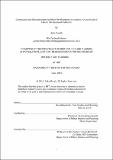Continuities and discontinuities in urban development institutions : a case study of Lahore Development Authority
Author(s)
Shoaib, Azka.
Download1140073134-MIT.pdf (511.5Kb)
Alternative title
Case study of LDA
Other Contributors
Massachusetts Institute of Technology. Department of Urban Studies and Planning.
Advisor
Bishwapriya Sanyal.
Terms of use
Metadata
Show full item recordAbstract
City development authorities are one of the key institutions in urban development and planning in South Asian cities. Pakistan and India share a history and have experienced the similar trend of Town Improvement Trusts established by the British transforming into Development Authorities. Both these forms of institutions had a similar mandate -- to improve the living standards in the city through planned development. Development authorities, in particular, were envisioned to undertake comprehensive and integrated master planning in the face of rapid urbanization that its predecessor failed to do so because of its institutional set up as a Trust. In this thesis, I focus on one such urban development institution in Lahore, Pakistan, namely the Lahore Development Authority (LDA) which has come under immense criticism in recent years. In order to understand the urban sprawl of Lahore and the complementary planned development, one needs to understand the institutions that are propelling this form of urban planning. I aim to understand the unequal development in Lahore through the lens of an institutional framework. The premise of my analysis is that even though the forms of institutions that come about and the way they evolve over time are influenced by the broader political and economic trends, it is the urban development institutions that dictate what kind of policies under its purview are produced, hence affecting the urban form. I argue that LDA was a continuation of the Lahore Improvement Trust in many ways, with a supposedly more comprehensive approach to planning, and it faced similar challenges as its predecessor and failed to achieve one of the objectives this parallel institutional structure set out to achieve: providing housing for the low-income groups. In my analysis, I highlight the role of legislation and political influence on LDA's operations. Political leadership and influence differentiate it from LIT and it can be its greatest strength if it is leveraged in the right way. In order to understand LDA's challenges and how these can be overcome, I analyse the following in this thesis: 1) why was LDA established and to what extent it was a continuation of its predecessor 2) how has LDA's policies evolved over the years and why, and 3) what are the challenges to cater to low income population for LDA and what are the ways in which it can achieve them?
Description
This electronic version was submitted by the student author. The certified thesis is available in the Institute Archives and Special Collections. Thesis: M.C.P., Massachusetts Institute of Technology, Department of Urban Studies and Planning, 2019 Cataloged from student-submitted PDF version of thesis. Includes bibliographical references (pages 71-73).
Date issued
2019Department
Massachusetts Institute of Technology. Department of Urban Studies and PlanningPublisher
Massachusetts Institute of Technology
Keywords
Urban Studies and Planning.